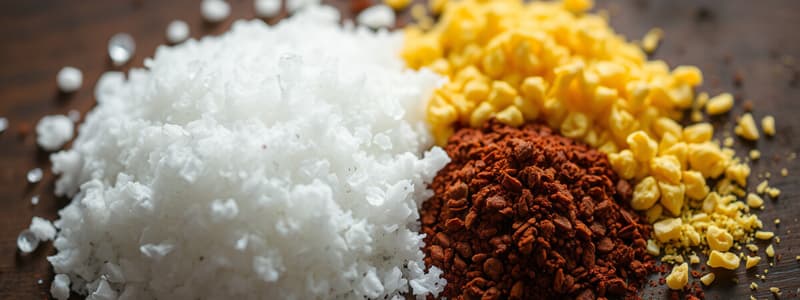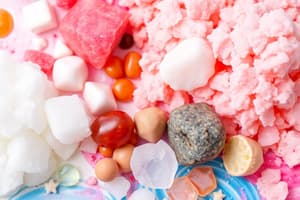Podcast
Questions and Answers
What are materials with a fixed composition called?
What are materials with a fixed composition called?
Pure substances
What are materials with varying compositions called?
What are materials with varying compositions called?
Mixtures
Which of the following is NOT a classification of matter?
Which of the following is NOT a classification of matter?
- Solutions (correct)
- Elements
- Compounds
- Mixtures
What can pure substances be further classified into?
What can pure substances be further classified into?
How can mixtures be grouped?
How can mixtures be grouped?
What is an example of a homogeneous mixture?
What is an example of a homogeneous mixture?
What is an example of a heterogeneous mixture?
What is an example of a heterogeneous mixture?
What physical means were suggested to separate components of mixtures in the activity?
What physical means were suggested to separate components of mixtures in the activity?
What was the purpose of using a magnifying glass in the activity?
What was the purpose of using a magnifying glass in the activity?
Flashcards are hidden until you start studying
Study Notes
Introduction to Pure Substances and Mixtures
- The classification of materials is essential for understanding their diversity.
- Examples of materials include visible substances like rocks and wood, as well as invisible ones like air.
- Materials can be categorized into pure substances (fixed composition) and mixtures (varying composition).
Classification of Matter
- Matter can be classified based on:
- Composition (pure substances vs. mixtures)
- Physical states (solids, liquids, gases)
- Properties of materials
Pure Substances
- Defined as materials with a fixed composition.
- Further divided into:
- Elements: Simple substances that cannot be broken down further.
- Compounds: Substances formed when two or more elements chemically bond.
Mixtures
- Characterized by varying compositions of two or more substances.
- Classified as:
- Homogeneous Mixtures: Uniform composition; components are indistinguishable (e.g., saltwater).
- Heterogeneous Mixtures: Non-uniform composition; components are visibly distinguishable (e.g., salad).
Learning Objectives
- Differentiate between pure substances and mixtures.
- Categorize pure substances as elements or compounds.
- Enumerate types of mixtures.
Warm-Up Activity
- Engage in classifying samples such as baking soda, table salt, fine sand, iron filings, and sulfur powder.
- Utilize tools like watch glasses, magnets, and strainers to observe and describe sample appearances and compositions.
Guide Questions for Understanding
- Describe the appearance of various matter samples.
- Discuss the composition of each sample.
- Explore reasons why certain mixtures can be separated by physical means.
- Determine methods to differentiate between pure substances and mixtures based on observations.
Observations and Recordings
- Utilize a data table to summarize observable characteristics of different samples, noting if components can be separated.
This structured understanding provides a foundational perspective on the nature of matter, crucial for further scientific exploration.
Studying That Suits You
Use AI to generate personalized quizzes and flashcards to suit your learning preferences.




